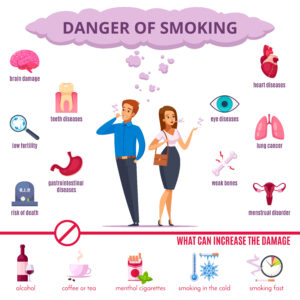7 Reasons Why College Students Think Smoking is Cool
According to a study published in the Journal of Applied Mathematics and Computing, cigarette smoking on college campuses is a major public health concern. According to a University of Arizona poll, smoking is a common social, gathering, or leisure activity among students. In 2016, China, India, and Brazil ranked among the top 10 countries producing tobacco. Universities should set up initiatives to inform students and offer counseling services to help them stop smoking.
College students cigarette smoking has long been a topic of research and discussion. Although not every college student thinks smoking is “cool,” but 7 Reasons contribute to certain students’ opinions of smoking as “cool” or a desirable behavior.
It’s crucial to highlight that smoking is generally prohibited owing to its well-documented health concerns, but here are 7 reasons why some college students think it’s cool:
- Social Pressure: Smoking is viewed as a method to fit in or be a part of a specific group in some social circles. College students frequently want social acceptance and may choose to smoke to identify with their peers who smoke.
- Effect of the Media: The media effect has influenced perceptions of smoking among young adults, with cigarette companies promoting it through appealing advertisements featuring stars smoking and promoting it as a fashion trend.
- Stress Reduction: Students began smoking as a coping mechanism for their familial and academic stress, but this behavior is not a solution to their problems and can have long-term negative health effects, thus more effective alternatives are required.
- Experimentation: The college years are a period dedicated to exploration and experimenting. Some students experiment with smoking out of curiosity or to challenge traditional norms and rules.
- Peer Influence: Smoking friends and acquaintances can have a big impact on a person’s smoking habits. Certain students may become smokers due to peer pressure.
- The Perception of Maturity: Smoking is sometimes connected to independence and adulthood. College students may consider it as a means to look more mature or grown-up.
- Fashion and Style: In present-day society, students smoke for the sake of style and fashion. They are frequently inspired to smoke by friends and other respectable people, who help them look better and gain acceptance from others.
College students are becoming more aware of the health concerns associated with tobacco use, which has resulted in campus policies prohibiting smoking and pushing quitting programs. The goal of public health campaigns and educational programs is to inform students about the risks associated with smoking, challenging the stereotype that it’s cool because of media and social pressure.
What are some of the health risks associated with smoking?
Smoking is a harmful habit that can cause various types of health problems. The Centers for Disease Control and Prevention (CDC) state that smoking cigarettes damages almost every organ in the body, results in lots of illnesses, and lowers smokers’ overall well-being.
The following are a few health hazards linked to smoking:

- Cancer: Smoking is a primary cause of cancer, which includes pancreatic, lung, throat, mouth, bladder, and kidney cancer.
- Heart disease: Smoking damages blood vessels and lowers blood flow to the heart, increasing the risk of heart disease.
- Stroke: Smoking damages the blood vessels of the brain, which raises the risk of stroke.
- Lung diseases: Smoking can lead to lung diseases such chronic bronchitis and emphysema.
- Respiratory infections: Smoking impairs immunity and makes it more difficult for the body to fight off infections like bronchitis and pneumonia.
- Reproductive issues: Smoking can lead to fertility problems in both men and women, as well as an increased risk of early birth, low birth weight, and sudden infant death syndrome (SIDS).
- Vision issues: Smoking raises the chance of macular degeneration and cataracts, both of which can result in blindness.
It is crucial to highlight that quitting smoking is not simple, but it is achievable with the proper assistance and solutions.
Also Read| 11 Reasons Why sugar is called White Poison
Why is it difficult to quit smoking?

Nicotine, a substance found in tobacco, is extremely addictive and can lead to both physical and emotional dependence, which makes quitting smoking challenging. When you smoke, nicotine causes the production of chemicals in your brain that make you feel happy. Your brain eventually becomes accustomed to nicotine and begins to depend on it to feel normal. When you try to quit smoking, you may encounter withdrawal symptoms such as irritation, anxiety, and difficulty focusing.
Smoking is frequently connected to certain persons, activities, and emotions aside from the physical dependence on nicotine. These “triggers” can make it hard to quit smoking. For example, if you regularly smoke after a meal or when you’re feeling stressed, it may be tough to leave the habit.
However, there are various tools available to assist people to quit smoking. Furthermore, counseling and support organizations can assist smokers in understanding and managing the difficulties they have when attempting to quit. Remember that quitting smoking is difficult and may require several efforts. The key to success is to be encouraging and helpful throughout the process.
What are some alternatives to smoking?
There are various smoking alternatives that can assist you in quitting smoking. Here are a few of them:
- Herbal cigarettes: These are tobacco-free cigarettes that are made from herbs like cinnamon, clover, and mint. They may be a good substitute for smokers who wish to give up but still value the ritual of smoking.
- Nicotine replacement treatment (NRT): NRT is a kind of medicine that gives the body nicotine without the negative effects of tobacco smoke. It comes in a variety of forms, including nasal sprays, gum, patches, lozenges, and inhalers.
- Vaping: Breath in vapor from an electronic cigarette or other vaping apparatus is known as vaping. Vaping devices work by heating a liquid, usually nicotine-containing, to produce an inhaled vapor.
- Chewing gum: Chewing gum can serve as a diversion from a desire to smoke and assist in lessening cigarette cravings.
- Exercise: Exercise can assist in reducing tension and anxiety, both of which are significant smoking triggers.
- Meditation: Meditation is a great way to relieve tension and anxiety while also providing a sense of peace and relaxation.
- Nutritious snacks: Eating nutritious snacks like fruits, vegetables, and nuts will help minimize cigarette cravings.
It’s crucial to remember that quitting smoking is difficult and may require several efforts. However, it is feasible to give up smoking permanently with the correct help and tools.

Thank you so much sir
Welcome Please try to share this information with your friends and relatives